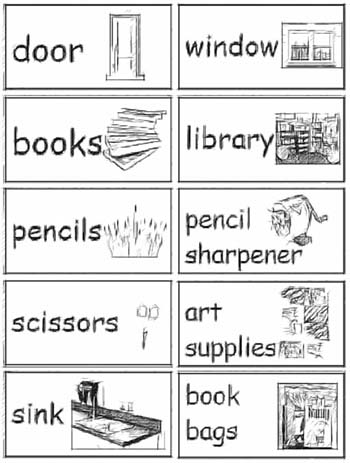5 Planning to use environmental print in your classroom
Activity 3: Look around your classroom – a planning activity
Look around your classroom. If you could make one or two changes to introduce environmental print, what would the changes be? How could these changes improve teaching and learning, do you think?
Are there practical steps you could take to make these changes?
Think of ways of making simple display boards using easily available materials such as discarded cartons, gunny bags and used packaging materials.
See Resource 2, ‘Involving all’ , to learn more about the value of including all students in the classroom environment.
Activity 4: Classroom labels
If you have a large class, you can do this activity with a different group of students each day.
For older students who have some experience of English, adapt this activity so that the cards are in English only and have the students write the cards themselves.
The resources you will need include card, pens and tape.
- Prepare some cards in two languages (Hindi and English, or home language and English) but leave some cards blank so students can contribute their ideas.
- Tell students you need their help to put the right label on the right item or shelf.
- Tell the students you will be learning and practising English together.
- Show the students the labels you have already made in English and one other language, for instance: ‘desk’, ‘window’, ‘chair’. Read the label to the students in the home language/Hindi and in English. Practise the words in English together.
- Ask students where the labels should be placed; for instance, on the bookshelf, at the door, on the table, on the desk.
- Ask the students what else could be labelled around the classroom, or where a sign could be placed to help people visiting the school.
- As you write out each label or sign, say the names of the letters and the words.
- Practise saying the words together in both languages.
Examples of classroom labels are shown in Figure 5.
Figure 5 Classroom labels.
When you label the classroom, you can refer to the words throughout the day as you teach. Ask students to find and point to the words that you use. Have students use the words in conversation with you and with each other, for instance:
- ‘Shusheela, please bring the books.’
- ‘Yes, I will bring the books.’
- ‘Thank you. Mohan, please go and open the door.’
- ‘Yes, I will open the door.’
Labelling the classroom will develop students’ reading, oral and listening skills in English. Your formative assessments will be based on oral questions and responses, and will help you identify areas where students need additional practice.
Activity 5: Interactive word wall
Read about the variety of word wall topics in Resource 1. Look at the pictures and think about what is possible and practical for your classroom.
Choose a topic to create a word wall in your classroom. Discuss your ideas with your fellow teachers or your head teacher.
Students should be able to see and touch the words and sentences that are displayed in the classroom. Daily word wall activities should be frequent, short and fun – and not just at specific times of the day. Encourage interaction with cheers and chants for new words of the week, as well as discussions that draw students’ attention to how words look and sound.
Remember: a teacher’s job is not finished when writing goes up on the classroom walls. You need to help students to use these resources. Daily word wall activities do not need to be long teaching sessions; they might be time to read and say the day of the week, read out students’ names, or read and say special weekly words. Integrate the word walls into your lesson plans and make opportunities for students to refer to the word walls independently for creative writing, spelling and vocabulary. Using the word wall frequently during the school day will also help you to feel more confident about using English in the classroom.
4 Teachers talk about environmental print

